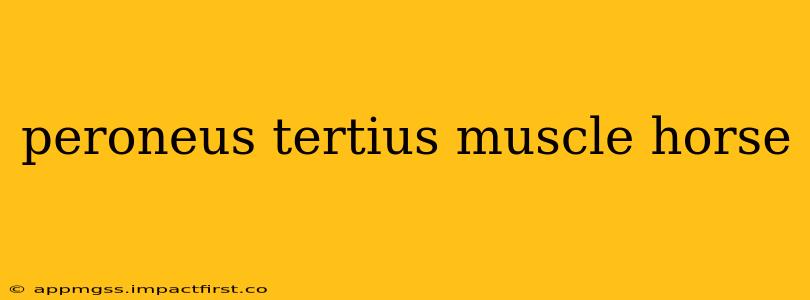The peroneus tertius muscle is a relatively small but important muscle located in the lower leg of horses. Understanding its anatomy, function, and potential clinical relevance is crucial for equine veterinarians and anyone involved in equine health and performance. This comprehensive guide will delve into the intricacies of the peroneus tertius, addressing common questions and concerns.
What is the Peroneus Tertius Muscle?
The peroneus tertius is a superficial muscle located in the craniolateral aspect of the equine distal limb. It originates from the distal third of the fibula and inserts on the dorsal aspect of the third metatarsal bone. Unlike its human counterpart, the equine peroneus tertius is distinct from the peroneus brevis and plays a significant role in the biomechanics of the hindlimb. Its relatively small size belies its important contribution to distal limb stability and movement.
What is the Function of the Peroneus Tertius Muscle in Horses?
The primary function of the peroneus tertius muscle is dorsiflexion of the hock and extension of the fetlock. It assists in stabilizing the lower limb, particularly during weight bearing and locomotion. This action is crucial for controlled movement and efficient propulsion during various gaits, from walking to galloping. Its contribution is particularly evident during high-speed activities where precise foot placement is paramount.
What are the Common Injuries or Problems Associated with the Peroneus Tertius Muscle?
While not as frequently injured as other muscles in the equine leg, the peroneus tertius can be affected by strains, tears, or contusions. These injuries often occur during strenuous activity or as a result of trauma. Diagnosis can involve a thorough physical examination, palpation, and possibly advanced imaging techniques such as ultrasonography.
How is Peroneus Tertius Muscle Injury Diagnosed?
Diagnosis typically involves a combination of:
- Clinical examination: Veterinarians will assess the horse's gait, observe for lameness, and palpate the affected area for swelling, pain, or muscle spasm.
- Ultrasonography: This imaging technique can provide detailed images of the muscle tissue, allowing veterinarians to identify tears, inflammation, or other abnormalities.
- Other diagnostic tests: Depending on the suspected injury, other diagnostic tests such as nerve blocks might be performed to pinpoint the source of lameness.
How is a Peroneus Tertius Muscle Injury Treated?
Treatment depends on the severity of the injury. Mild strains may respond well to conservative management, including rest, anti-inflammatory medication, and controlled exercise. More significant injuries, such as complete tears, may require surgical intervention. The recovery period varies depending on the severity of the injury and the individual horse.
What are the Signs of a Peroneus Tertius Problem in a Horse?
Signs of a peroneus tertius problem might include subtle lameness, particularly noticeable at faster gaits or during turning. The horse may show reluctance to flex or extend the hock. Palpation might reveal tenderness or swelling over the muscle. These signs often need careful assessment to distinguish them from other potential causes of lameness in the hindlimb.
Can a Horse Still Perform with a Peroneus Tertius Injury?
The impact of a peroneus tertius injury on athletic performance depends on the severity of the damage. Mild injuries may only cause subtle limitations, while severe tears can significantly impair the horse's ability to perform. Veterinary guidance is crucial in determining the suitability of the horse for continued athletic work following an injury. Rest and rehabilitation are key elements in the return to athletic performance.
Disclaimer: This information is for educational purposes only and should not be considered veterinary advice. Any concerns regarding the health of your horse should be addressed by a qualified equine veterinarian. Early diagnosis and proper treatment are crucial for optimal outcomes.
